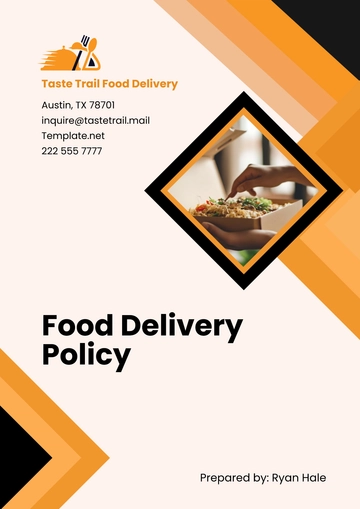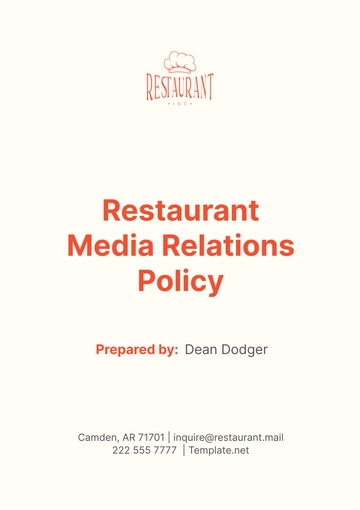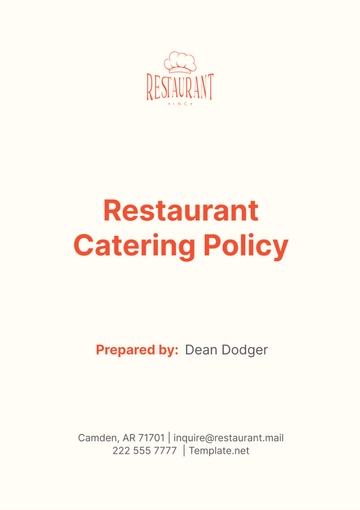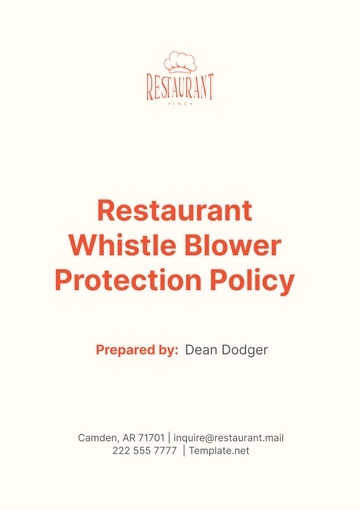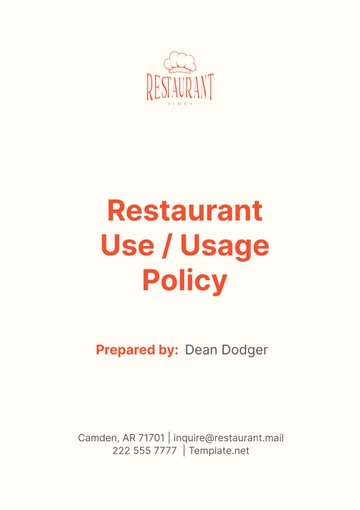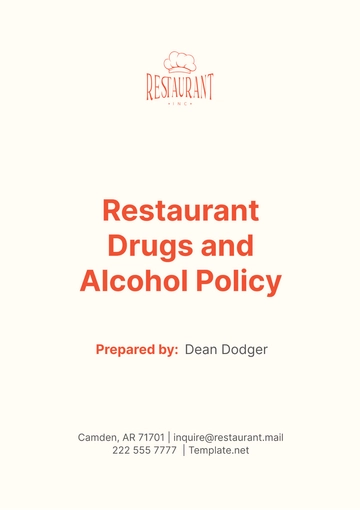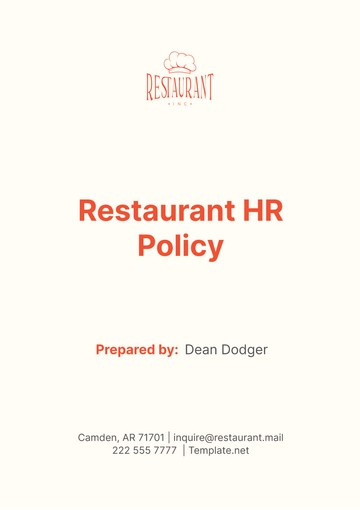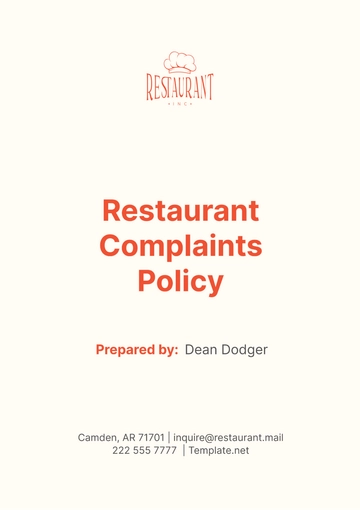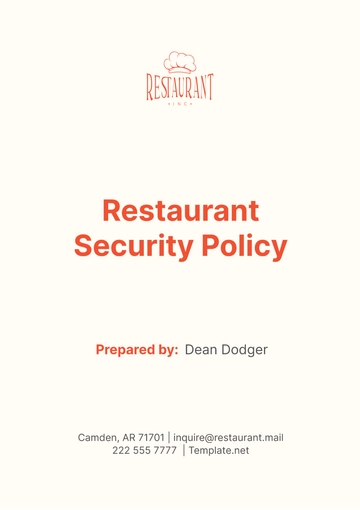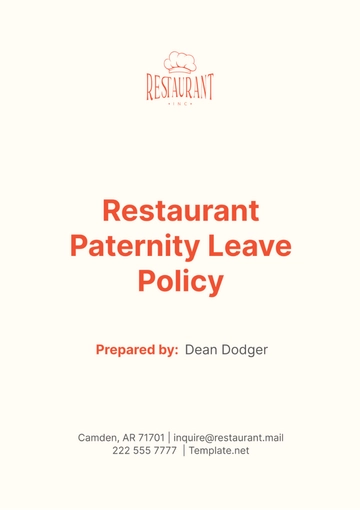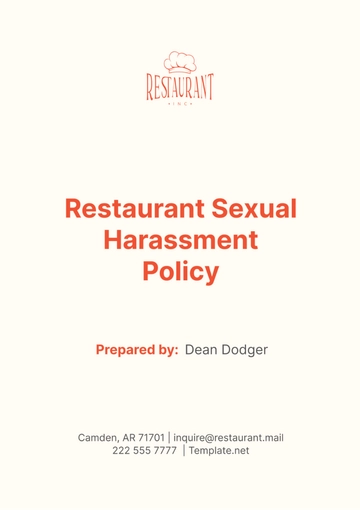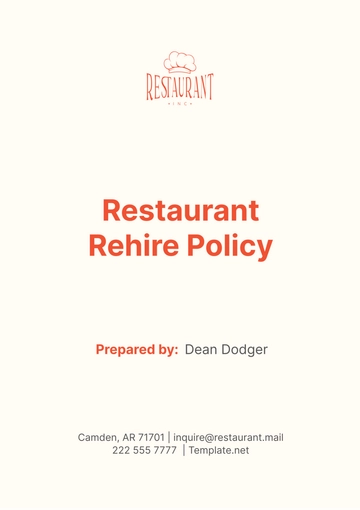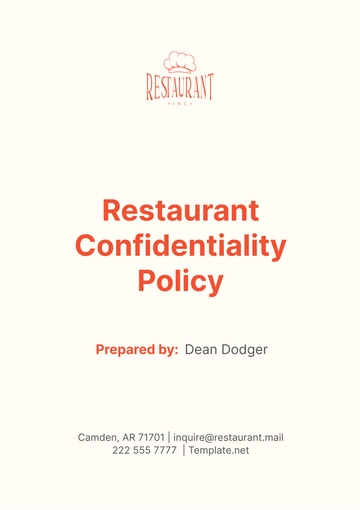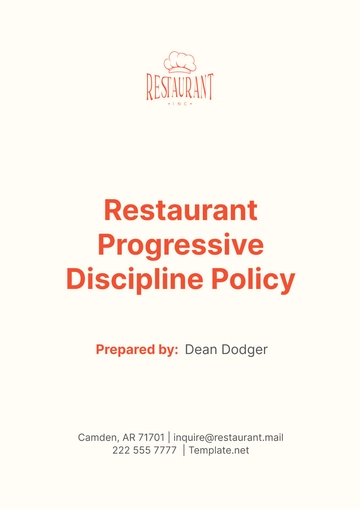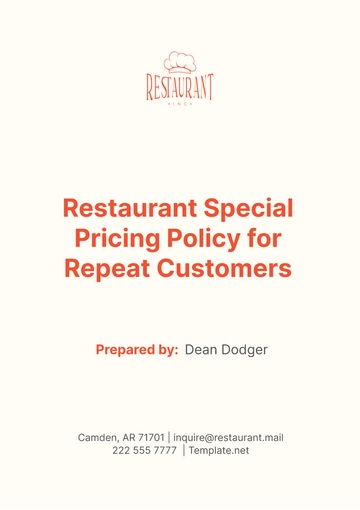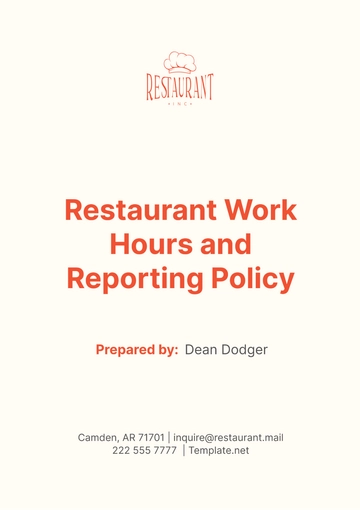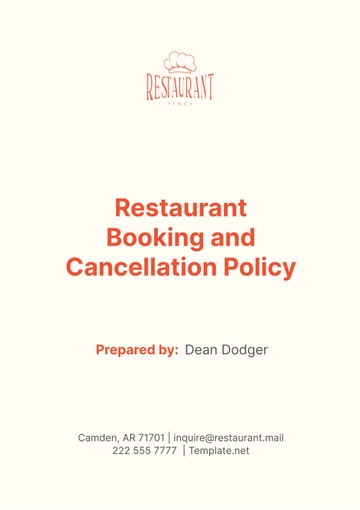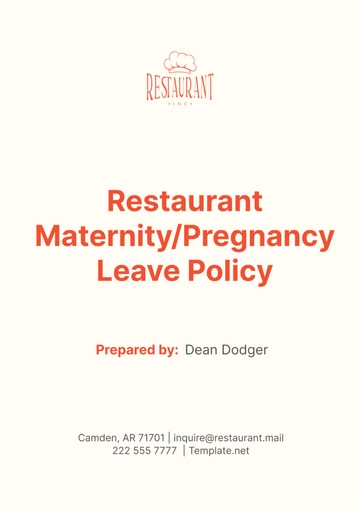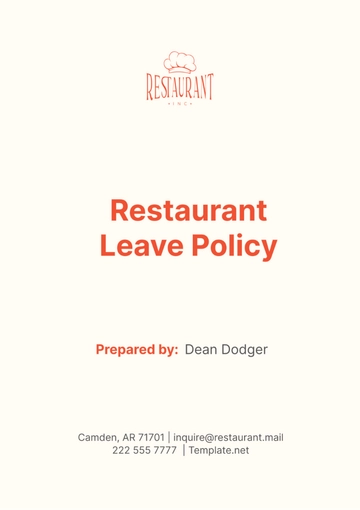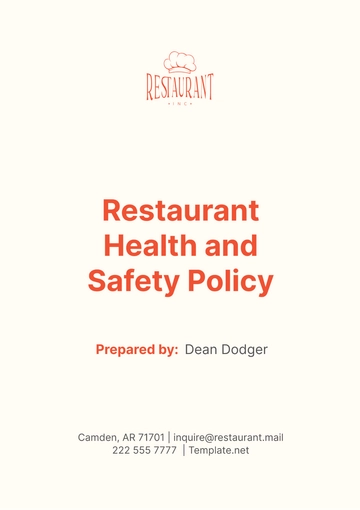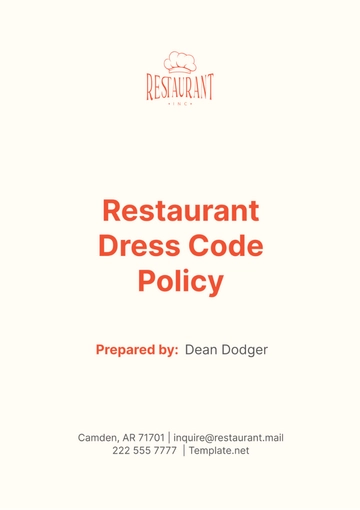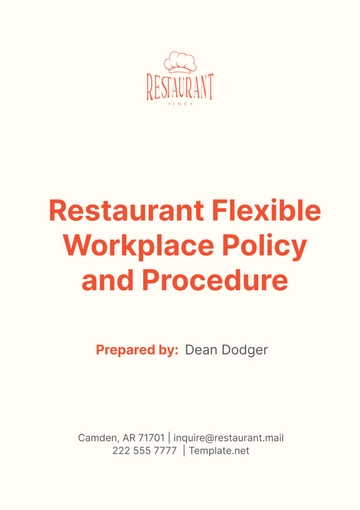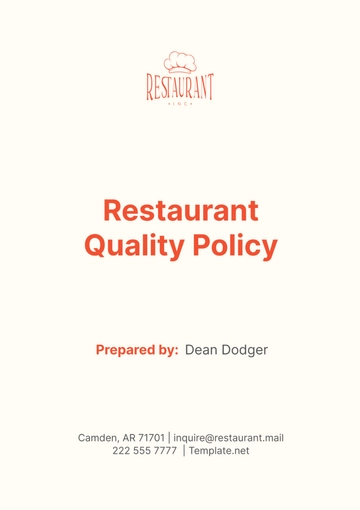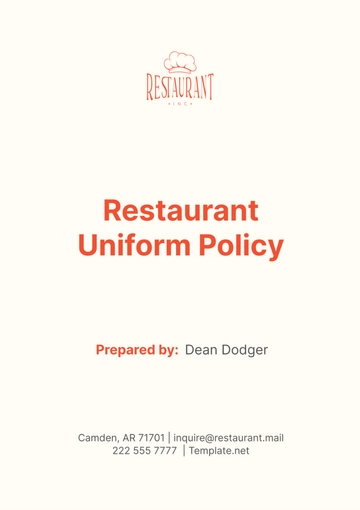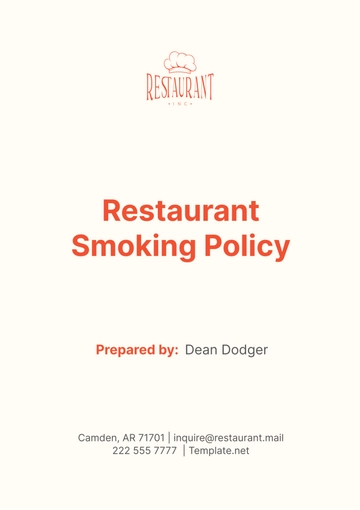Free Restaurant General Safety Policy
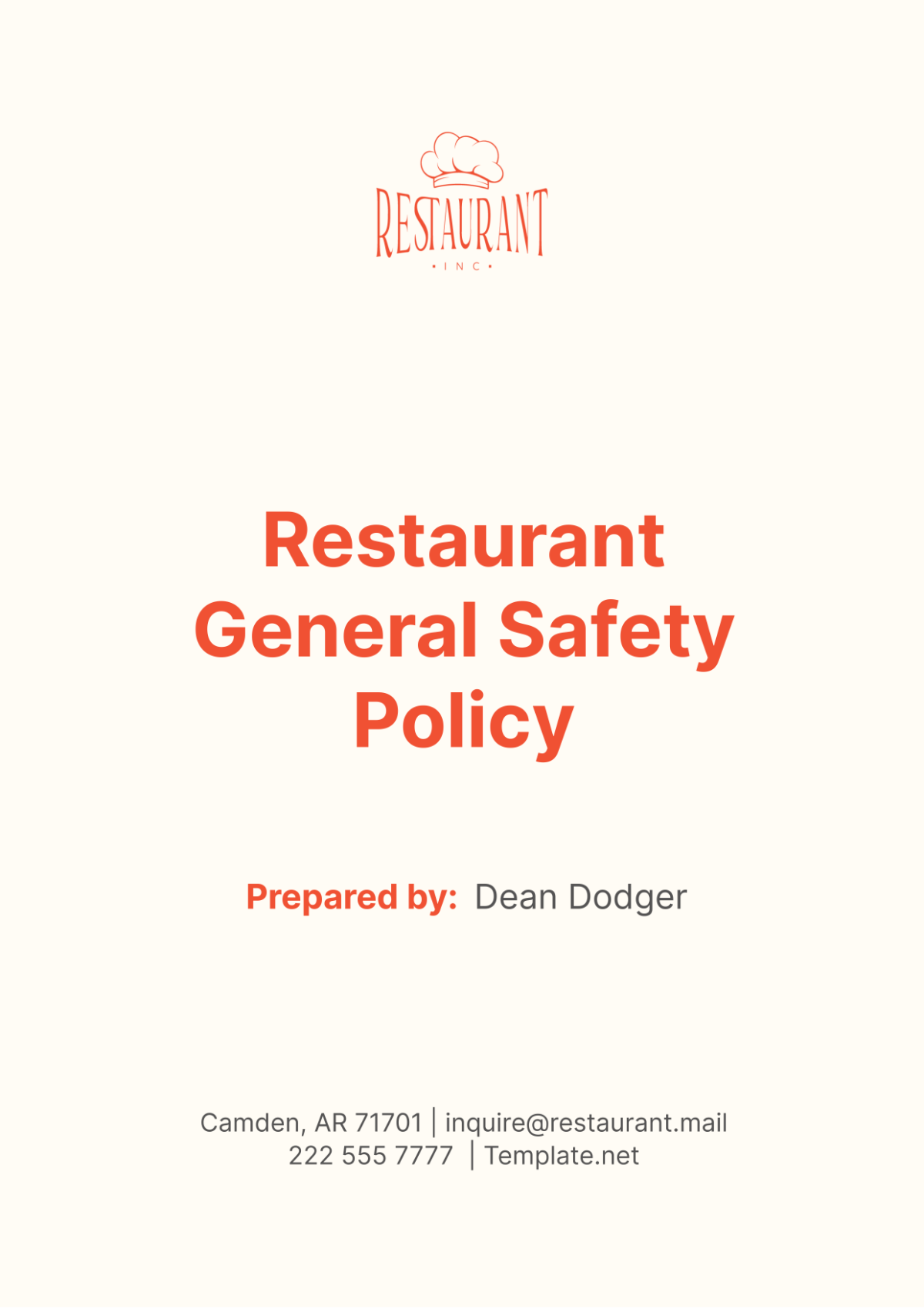
I. Policy Overview
[Your Company Name] is committed to providing a safe and healthy work environment for all employees, contractors, and visitors. Our General Safety Policy outlines our commitment to maintaining high safety standards and ensuring compliance with all relevant regulations and best practices.
II. Scope
This policy applies to all employees, contractors, and visitors at our restaurant. It is the responsibility of everyone involved to adhere to the guidelines outlined in this document to maintain a safe and healthy environment.
III. Responsibilities
Safety is everyone's responsibility. Management and employees must work together to create and maintain a safe work environment. Clear understanding of responsibilities is crucial to achieving this goal.
A. Management
Management is responsible for ensuring that all safety procedures are implemented and followed. This includes providing necessary safety training, conducting regular safety inspections, and addressing any identified hazards promptly.
B. Employees
Employees are responsible for understanding and following all safety policies and procedures. They must report any unsafe conditions or practices to their supervisor immediately and participate in all required safety training and drills.
Emergency Response: All employees must familiarize themselves with the emergency response plan and know the location of emergency exits and assembly points. In the event of an emergency, employees must follow the instructions of designated emergency response personnel.
Personal Protective Equipment (PPE): Employees must wear appropriate PPE, such as gloves, goggles, or helmets, when required for their job duties. PPE must be maintained in good condition and replaced as necessary.
Hazard Communication: [Your Company Name] will provide employees with information on hazardous chemicals in the workplace. Employees must follow all instructions and warnings regarding the safe use and handling of chemicals.
Accident Reporting: All accidents, injuries, and near misses must be reported to management immediately. Employees must cooperate with any investigations into the cause of accidents and work to prevent similar incidents in the future.
Workplace Violence Prevention: [Your Company Name] has zero tolerance for workplace violence. Any threats or acts of violence must be reported immediately to management or HR for appropriate action.
Safety Committees: [Your Company Name] may establish safety committees to help identify and address safety issues in the workplace. Employees are encouraged to participate in safety committee meetings and contribute to improving safety practices.
Safe Driving Policy: Employees who drive as part of their job duties must adhere to safe driving practices, obey all traffic laws, and follow company policies regarding vehicle use and maintenance.
Alcohol and Drug Policy: [Your Company Name] prohibits the use of alcohol and illegal drugs on company premises or while on duty. Employees found to be under the influence of alcohol or drugs may be subject to disciplinary action, up to and including termination.
By adhering to these policies and working together, we can create a safe and healthy work environment for everyone at [Your Company Name]. Your safety is our top priority.
IV. General Safety Guidelines
The following General Safety Guidelines are designed to ensure the well-being of all employees and visitors at [Your Company Name]. It is imperative that everyone follows these guidelines to maintain a safe and secure workplace environment.
A. Workplace Safety
All work areas must be kept clean and free from hazards. Spills must be cleaned immediately, and all equipment and utensils should be stored properly after use.
B. Fire Safety
All employees must be familiar with the location and use of fire extinguishers, fire alarms, and emergency exits. Regular fire drills will be conducted to ensure everyone is prepared in the event of a fire.
C. Food Safety
All food must be stored, prepared, and served according to food safety standards to prevent foodborne illnesses. Employees must practice good hygiene, including washing hands regularly and wearing appropriate protective clothing.
Policy | Description |
|---|---|
Storage | Food must be stored at the correct temperature and in designated areas to prevent contamination. |
Preparation | All food must be prepared following safe practices, including proper cooking temperatures and avoiding cross-contamination. |
Service | Food must be served promptly and at safe temperatures to prevent the growth of harmful bacteria. |
D. Equipment Safety
All equipment should be used according to manufacturer instructions. Employees must report any faulty equipment immediately to management. Regular maintenance checks will be conducted to ensure all equipment is in good working condition.
Policy | Description |
|---|---|
Proper Use | All equipment should be used according to manufacturer instructions. |
Reporting | Employees must report any faulty equipment immediately to management. |
Maintenance | Regular maintenance checks will be conducted to ensure all equipment is in good working condition. |
E. Electrical Safety
Employees should not attempt to repair or tamper with electrical equipment unless they are trained and authorized to do so. All electrical cords and outlets should be in good condition and used properly.
F. Chemical Safety
All chemicals must be stored, handled, and disposed of according to safety regulations and manufacturer instructions. Employees must use appropriate protective equipment when working with chemicals.
G. Personal Safety
Employees should be mindful of their personal safety at all times. This includes wearing appropriate footwear, avoiding horseplay, and following safe lifting practices.
V. Emergency Procedures
Adherence to these emergency procedures is critical to ensuring the safety and well-being of everyone in the workplace. Regular training and drills will help to familiarize employees with these procedures and ensure a quick and effective response in case of an emergency.
Medical Emergencies
In the event of a medical emergency, employees should call 911 immediately and provide assistance until medical professionals arrive.
A first-aid kit is available on-site for minor injuries.
Designated employees should be trained in CPR and basic first aid.
Evacuation Procedures
In case of an emergency that requires evacuation, employees and customers should use the nearest exit and follow the instructions of the emergency personnel.
All staff should be familiar with the evacuation routes and assembly points.
Regular evacuation drills should be conducted to ensure everyone knows what to do in an emergency.
Fire Emergencies
In the event of a fire, activate the nearest fire alarm pull station and call 911.
If safe to do so, use a fire extinguisher to extinguish small fires.
Do not use elevators during a fire.
Follow evacuation procedures and assemble at the designated area.
Hazardous Material Spills
In case of a hazardous material spill, employees should evacuate the area immediately and notify a supervisor.
Do not attempt to clean up the spill unless trained to do so.
Follow all safety procedures and precautions related to the specific hazardous material.
Utility Failure
In the event of a utility failure (such as power, water, or gas), employees should notify the designated personnel immediately.
Follow any instructions provided by emergency personnel and be prepared to evacuate if necessary.
Do not attempt to restore utilities without proper training.
Adherence to these emergency procedures is critical to ensuring the safety and well-being of everyone in the workplace. Regular training and drills will help to familiarize employees with these procedures and ensure a quick and effective response in case of an emergency.
VI. Training and Communication
All employees will receive safety training during their orientation and at regular intervals. The training will cover general safety practices, emergency procedures, and specific hazards related to their job functions. Regular safety meetings will be held to discuss any concerns and reinforce safety practices.
Training Type | Frequency | Content |
|---|---|---|
Safety Orientation | Upon hiring | Overview of general safety practices and workplace hazards. |
Job-Specific Training | As needed | Detailed training on specific hazards related to job functions. |
Refresher Training | Annually | Review of key safety practices, updates on procedures. |
A. Communication Plan
Safety Bulletin Boards: Posters and notices will be displayed in common areas to communicate important safety information and updates.
Safety Meetings: Regular safety meetings will be held to discuss any safety concerns, review incidents, and reinforce safety practices.
Reporting Procedures: Employees are encouraged to report any safety hazards or concerns to their supervisor immediately.
Training and effective communication are essential components of our safety program. By providing regular training and maintaining open lines of communication, we can ensure that all employees are aware of and adhere to our safety policies and procedures.
VII. Policy Review
This policy will be reviewed annually and updated as necessary to ensure its effectiveness and compliance with relevant laws and regulations. By working together and adhering to this Restaurant General Safety Policy, we can create a safe and enjoyable dining experience for everyone.
- 100% Customizable, free editor
- Access 1 Million+ Templates, photo’s & graphics
- Download or share as a template
- Click and replace photos, graphics, text, backgrounds
- Resize, crop, AI write & more
- Access advanced editor
Ensure a safe work environment with the Restaurant General Safety Policy Template, exclusively on Template.net. This editable template offers a framework for establishing and maintaining a safe workplace. With seamless editing in our Ai Editor Tool, create a safety policy that promotes a culture of safety and protects your employees.
You may also like
- HR Policy
- Restaurant Policy
- Company Policy
- Accounting Policies and Procedures
- Website Policy
- Privacy Policy
- Safety Policy
- School Policy
- IT and Software Policy
- Law Firm Policy
- Construction Policy
- Interior Design Policy
- Travel Agency Policy
- Education Academic Policy
- Security Policy
- Real Estate Policy
- Expense Policy
- Software Policy
